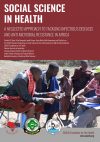The World Health Organisation say that the XE COVID variant (a mixture of two Omicron strains) could be 10% more transmissible than Omicron itself
In a recent analysis of global data, the World Health Organisation (WHO) found that a new, recombinant variant has been identified in the UK. A recombinant variant is the combination of existing strains, as opposed to a truly new evolution of the virus.
Recombinant strains are highly common with coronaviruses, especially when transmission of the virus globally remains high.
What is the XE COVID variant?
The XE variant is a recombination of two strains of Omicron – specifically, BA.1 and BA.2.
The WHO say that it was first detected in the UK, on 19 January. As of 29 March, 600 sequences have been reported for XE.
So far, there is not enough extensive, peer-reviewed information about the way XE impacts the human body to create a list of specific symptoms. But there is an estimate of how easily the recombinant can infect people, with XE estimated to have a 10% transmission advantage over the BA.2 strain of Omicron.
10% more infectious than Omicron would risk more reinfection
Omicron replaced Delta as the globally dominant strain of the virus, in late 2021. While Delta was notoriously more intensive, leaving a higher level of ICU hospitalisations and death in its wake, Omicron appeared to have a less fatal outcome – while spreading significantly faster.
Any increased level of transmissibility from what Omicron was doing in early 2022, could present significant issues for overwhelmed healthcare systems and countries that have lifted precautionary measures.
Omicron was also more capable of rapid reinfection in the same person than any previous mutation.
Reinfection has been more commonly reported with Omicron, with one study in Denmark finding “mild disease” after two bouts of Omicron. However, each case of infection opens up the likelihood of Long COVID, which remains difficult to understand for healthcare professionals.
In a mid-2021 study, Characterizing long COVID in an international cohort: 7 months of symptoms and their impact, the authors wrote that: “A significant number of patients with COVID-19 experience prolonged symptoms, known as Long COVID. Few systematic studies have investigated this population, particularly in outpatient settings.
“Hence, relatively little is known about symptom makeup and severity, expected clinical course, impact on daily functioning, and return to baseline health.”
Data sharing remains essential to staying ahead of COVID mutations
Regular sequencing of the virus leads to discoveries of new variants. Epidemiology experts at the WHO describe the “timely sharing of data” as “critical” for understanding the behaviour of COVID-19.
The UK has defunded multiple studies tracking the spread and mutation of COVID in their population, with PCR testing phased out. The country will no longer sequence and monitor the virus, while the WHO continues to expect new mutations.
The health organisation, in a recent update on COVID, said: “The evolution rate and the risk of the emergence of new variants, including recombinants, is still very high.”
Editor's Recommended Articles
-
Must Read >> UK stops tracking COVID levels in healthcare workers




























